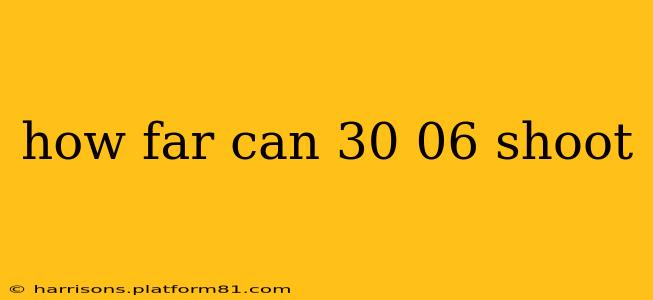How Far Can a .30-06 Shoot? The Range and Factors Affecting It
The .30-06 Springfield cartridge is a legendary round, known for its power and accuracy. But the question of how far it can shoot is complex, not having a single definitive answer. It depends on several interacting factors. Let's delve into the specifics.
Maximum Effective Range vs. Maximum Range:
It's crucial to differentiate between these two concepts:
-
Maximum Effective Range: This refers to the distance at which a skilled shooter can consistently hit a human-sized target with sufficient accuracy to inflict a disabling wound. This is significantly shorter than the maximum range. Various factors like bullet drop, wind drift, and sight adjustments strongly influence this. For the .30-06, this is generally considered to be around 1,000-1,200 yards (914-1097 meters), depending on the ammunition used and environmental conditions. Beyond this, accuracy significantly degrades, making reliable hits highly improbable.
-
Maximum Range: This is the theoretical maximum distance a bullet can travel before impacting the ground. This is far greater than the effective range. For a .30-06 round, the maximum range can reach 3-4 miles (4.8-6.4 kilometers) or even slightly further depending on the bullet's ballistic coefficient and environmental conditions (like a negligible headwind). However, at these distances, the bullet's velocity will be drastically reduced, and its trajectory wildly unpredictable.
What Factors Influence .30-06 Shooting Distance?
Several factors influence how far a .30-06 round can travel and how effectively it can hit its target:
1. Ammunition: Different .30-06 ammunition types have varying ballistic coefficients. Heavier, more aerodynamic bullets will travel further and retain their velocity better than lighter, less aerodynamic ones. The powder charge also significantly impacts muzzle velocity and overall range.
2. Barrel Length: A longer barrel generally translates to higher muzzle velocity, leading to increased range. However, beyond a certain point, the gains diminish.
3. Rifle Type: The rifle's accuracy and stability affect the bullet's trajectory. A more accurate rifle with a good stock design and a well-maintained barrel will allow for more consistent and longer shots.
4. Environmental Conditions: Wind speed and direction have a major effect on bullet trajectory at longer distances. Temperature and humidity also impact the bullet's flight path. These factors make long-range shooting extremely challenging without advanced ballistic calculations and adjustments.
5. Shooter Skill: A skilled shooter, proficient in range estimation, wind reading, and proper technique, can significantly extend the effective range of their .30-06 rifle.
What about other calibers?
The .30-06 isn’t alone in its long-range potential. Many other cartridges boast impressive range, though their effective range varies considerably.
Is there a maximum range for all bullets?
The maximum range is always subject to gravity and air resistance. This means all bullets will eventually fall to the ground.
In summary, while a .30-06 round can technically travel several miles, its effective range is significantly shorter, typically around 1,000-1,200 yards. Understanding the limitations of the cartridge and the various factors influencing its performance is crucial for safe and accurate shooting.
